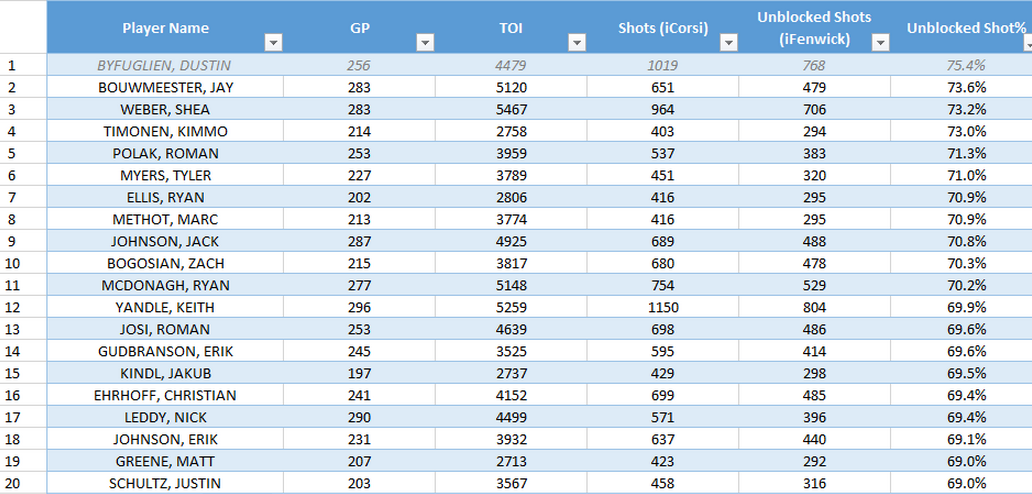Getting pucks through shot-blocking layers becoming coveted skill for NHL D-men
Though it seems counterintuitive, the volume of humans who seem to enjoy getting hit in the shins with hockey pucks has exploded over the past decade of NHL hockey. What that's come to mean for today's defensive players, is that blocking shots no longer gets you a pat on the back; not blocking shots just gets you a seat on the bench.
That means getting pucks through to the net has become increasingly difficult, which, in turn, has made the ability to avoid the shot block a coveted skill.
I've heard the shift to more heavily prioritized shot-blocking described in football terms by an NHL coach.
First, offensive defensemen have to get their special object past the oncoming rusher, like a quarterback. That defensive winger is J.J. Watt, rushing out and doing everything possible to get to the opposition - or at least steal the puck, block the shot attempt, or steer it off target.
Many years ago in hockey, that was pretty much it. You got it by that first guy and the puck generally found its target, as defensive players were locked onto a man and barely concerned with the puck. "Get sticks up" was the defensive player's goal after a shot from the point.
Today, you also have to get the puck by Richard Sherman, who's acting as a second layer in more of a zone defense ("fronting," in hockey parlance), primarily interested in intercepting or knocking down the attempt. "Sherman" still has to know where his guy is, but if he can get a hold of the game's most coveted commodity, the location of his check no longer matters.
When today's D-men pull the trigger, they need to be Aaron Rodgers and see that second layer. If they don't, the puck is coming back at them - and now they're flat-footed, and likely about to spend the rest of the shift in the D-zone, assuming they haven't given up an odd-man rush and goal.
So, a block is basically a flat-out turnover; a missed net - provided the shooter has dragged the puck off the wall and into the middle as most (all?) coaches ask - still leaves the puck in a dangerous, recoverable position; and a shot on goal can either go in, or create a rebound and general chaos.
I know I've beaten the dead horse pretty thoroughly here, but it’s tough to overstate how important it is to have success once the puck gets run from low to high.
Evaluating this at the NHL level can be frustratingly anecdotal ("it seems like so-and-so is someone who does this well?"). It's almost impossible to pull, numbers-wise, from the stats we have available to us.
As for the numbers we do have … well, some guys miss the net on purpose to avoid blocks, using the angle of the boards as a pass, but that's tallied the same as a wild bomb from the boards that wraps its way out of the zone. Some guys shoot the puck off the net at sticks, slap-pass style - because they've got vision - but that's not an easily quantified play. Other defensemen are paired with offensive dynamos and end up with clear lanes because they're forgotten, while the opposite situation exists too.
Still, there seems to be at least some separation between players. You can see below that the top-20 D-men in avoiding block attempts over the past four years (minimum 400 tries) is a list of generally excellent defensemen:

(Stick-tap to Domenic Galamini for the chart.)
But again, we're hardly able to definitively say, "Here are guys who excel at getting pucks through." On the surface, those names seem to have made the list for widely varying reasons.
Shea Weber and Dustin Byfuglien have ROCKETS for shots, so you can see why some players "oopsie!" it and fail to get in front of their attempts. Roman Polak could be one of those guys nobody respects offensively, so when he does get the puck, he's open. Marc Methot could be there because he's left alone while defenses struggle to contain the uncontainable Erik Karlsson (who likely isn't on the list himself because of all that extra attention).
But in general, the names there make you go, "Yeah, that makes sense."
Because of all the "noise" in the numbers, as statisticians say, this is an area where coaching and pro scouting are crucial, and it's an area many teams are targeting for improvement. The big boomer isn't useful if it’s shot directly into a trampoline, so expect to see more players - particularly the forward in the high slot - offering options for their QB.
And expect to see D-men who do this well rewarded for it. How we think about hockey is always evolving, and it seems to be favoring players who can process the game exceedingly well over guys who just have raw skill.
Big and tough is great, but not if it's always trapped in its own zone. Speed kills, but not when it's forced to stand still. And hard shots inspire awe. Though, if a guy doesn't have the meat calculator to know when to use it, it's as good as a muffin. After all, the best NFL quarterbacks aren't necessarily the guys who can throw the ball farthest.
HEADLINES
- Avalanche put up 9 goals in blowout over Oilers
- Blue Jackets' Olivier ejected for boarding Canucks' Pettersson
- 1 quick thought on all 32 teams a month into the season
- Celebrini scores 10th goal as Sharks top Panthers for 3rd straight win
- Golden Knights' Karlsson ruled out after apparent injury vs. Ducks